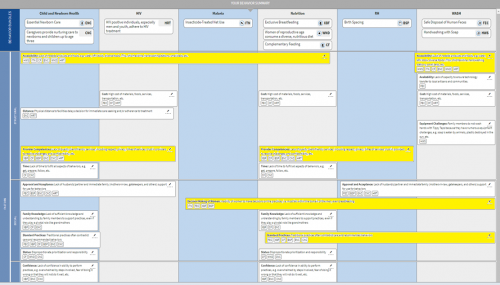Summarizing your priority behaviors means:
- Gathering all the behavioral information you have, across behaviors and along pathways to change (your full set of Behavior Profiles).
- Consolidating information that is similar.
- Then choosing the most critical elements to address.
What do we mean by “similar” information? Information that says the same thing, but in a different way. For example, “I live too far from the markets'' and “The markets are in places far from my home”. They have the same intent – distance to markets is a challenge – just expressed differently.
What about the “most critical” elements to address? These are elements that must be addressed, involved, or implemented for anything else to succeed. Things like insufficient access to products if products must be in place to practice the behavior. Then, in that case, improving access is critical.
A core tool in summarizing your Behavior Profiles is the Behavior Summary. Creating a Behavior Summary strengthens your ability to stay focused on behaviors, critical factors, supporting actors and their actions, and impactful program strategies. It’s a simple-to-follow, synthesized overview of your Behavior Profiles that shows the synergies between priority behaviors.
A Behavior Summary is an AI-supported way to consolidate, synthesize, and foreground the essentials:
- What factors are most important across all your behaviors? If you address these factors they can impact many, or all, of your behaviors.
- What supporting actors are most important across all your behaviors? If you involve these supporting actors it will positively influence many, or all, of your behaviors.
- What strategies are most important across all your behaviors? If you implement these strategies you will overcome or leverage several critical factors across many, or all, of your behaviors.
- What are any critical factors, supporting actors, and/or program strategies that must be addressed, which are unique to only one behavior or two but so important that you must work on them?
- How do you determine what is critical to keep and what you can let go?
This might sound like a lot of work. But our AI-powered program does much of the work for you. It sorts factors, supporting actors, and strategies into groups that can be summarized. And we all know AI isn’t perfect. So, we offer the flexibility to change the groupings if you don’t agree with what your AI social and behavior change (SBC) assistant suggests.
Generating the at-a-glance picture of your full behavioral impact potential, via your Behavior Summary, comes together in six steps. 
First, you group your priority behaviors by:
- location (such as home or clinic),
- or by primary actors (like policymakers or caregivers),
- or by topic (for example, malaria, crop farming, fisheries, etc.).
You start by summarizing commonalities and highlighting differences to keep in mind within each behavior grouping.
Second, you look at the factors within each behavior grouping, combine common factors, and synthesize what you are seeing. For example, if you have two factors stating the following, you might summarize them like this:
Factor Statement 1: Gender roles for childcare are a barrier to help for newborns at home.
Factor Statement 2: Men play a significant role in malaria nets use in the household, either encouraging or discouraging its use.
Summary: Insufficient emphasis on decision making role of women in matters directly affecting women’s health.
Third, you will do the same thing for supporting actor actions within each behavior grouping. For example, if you have the following two supporting actor actions, you could summarize in this way:
Supporting Actor Action Statement 1: Local government actors justify decisions for expenditures and projects for citizens.
Supporting Actor Action Statement 2: Local government actors review accuracy of financial reports and expenditures regularly.
Summary: Local government actors clarify expenditures and seek training to enhance voting experience.
Fourth, you complete the same task for program strategies. Identify similar strategies, put them together, then summarize what they say. It could look something like this:
Strategy Statement 1: Policies and Governance – Clarify and enforce clear newborn care guidelines in health facilities.
Strategy Statement 2: Policies and Governance – Review existing procedures and incorporate needed sections, i.e., mandatory orientation of service providers, monitoring (accountability mechanism).
Summary: Policies and Governance – Review, revise, enforce supportive preventative directives and guidelines.
Fifth, now you have summarized factors, supporting actors and their actions, and program strategies within each of the behavior groupings. It’s time to look across all behavior groupings and summarize again, so your synthesized picture covers all behaviors. The merged view in our Behavior Summary tool lets you do this quickly and easily. It shows you all the summarized statements you have created, by category (factor, supporting actors, strategy), for all behavior groupings. You can see everything in the same place, on the same page. Then you can synthesize again across the behavior groups. In the end, you’ll land on a final set of summarized statements for your program by factor, by supporting actor and their actions, and by program strategy!
Sixth and finally, you take all your final summarized statements and decide what is truly critical to your program’s success. You cut down to the essentials – the factors you must address, supporting actors you must involve, and program strategies you must implement. Our curated process lets you feel confident that you will impact your priority behaviors, within your timeframe and within your resources, both human and financial. You will have a trustworthy set of statements that you can move into your strategy results framework.
If you’d like to see a couple of samples of a completed Behavior Summary, check out this one for Democracy and Governance or this one for Health.





 The Manoff Group was acquired by JSI in 2022.
The Manoff Group was acquired by JSI in 2022.